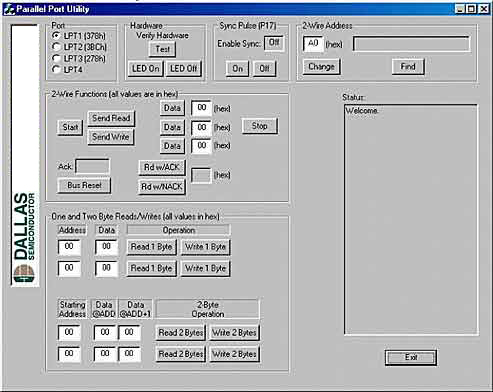- If you're having a hardware problem that you suspect is caused by a device driver, your first stop should be Device Manager. Open the properties dialog box for the device, and use the following buttons on the Driver tab to perform maintenance tasks: Update Driver.
- In Microsoft Windows, I 2 C is implemented by the respective device drivers of much of the industry's available hardware. For HID embedded/SoC devices, Windows 8 and later have an integrated I²C bus driver. In Windows CE, I 2 C is implemented by the respective device drivers of much of the industry's available hardware.
- First Stop Safety Port Devices Driver License
- First Stop Safety Port Devices Driver
- First Stop Safety Port Devices Drivers
The car you're driving today is, without question, far safer than a similar car of 40 years ago—even if your car is 20 years old. That's because, since 1979, there has been an official crash-testing regime and increasingly high standards for vehicle safety and equipment. Before the 1970s, some carmakers worked hard to build a reputation for safety through vehicle design and extra safety equipment, but most did not.
How vehicle safety evolved
To hot remove or insert a USB disk storage device, first stop vold(1M) by issuing the command /etc/init.d/volmgt stop. After the device has been removed or inserted, restart vold(1M) by issuing the command /etc/init.d/volmgt start. You can also permanently disable vold for removable devices by commenting out the rmscsi line in vold.conf.
In fact, the automotive industry as a whole has fought many of the improvements to vehicle safety to date, from when seat belts were first made mandatory in 1968 to the airbag requirement of 1991 (even though it didn't go into effect until 1998). Thanks to the work of the United States government through the Department of Transportation's National Highway Traffic Safety Administration (NHTSA), however, we now have official government crash-test ratings for new cars, an in-depth set of safety standards, regulations, and equipment requirements spelled out in the Federal Motor Vehicle Safety Standards (FMVSS), and active development of ever-more advanced safety technology by the carmakers themselves almost industry-wide.
This last aspect of the change—driven by technological innovations in and around the automotive industry—is definitely a change from the strong resistance to increased safety standards in decades past. That's not to say the automotive industry doesn't lobby against changes to this day (they do), but the amount of time and money invested in bringing new safety features to market is far more substantial, and nearly universal for all vehicle brands in the industry. This technological competition for enhanced safety is what has put us on the precipice of self-driving cars, which could, in theory, nearly eliminate vehicle-related injury and death.
First Stop Safety Port Devices Driver License
But before we jump ahead into the future, let's take a look back on how vehicle safety evolved over the years.
1899: First Recorded Fatality

The first recorded traffic death in the U.S. happened way back in 1899, when Henry Hale Bliss was hit and killed by a motorized carriage in New York City, perhaps because the first stop sign wasn't installed until 1914—in Detroit. The three color stoplight followed four years later (also in Detroit).
1908: First Safety Equipment
Even the most basic safety equipment had to be invented sometime. In 1908, features like the windshield, headlights, and speedometer were optional equipment on the most popular car on the road, the Ford Model T. The first car with standard safety glass (employing lamination to ensure the glass would break into tiny, contained pieces rather than shattering into large, deadly shards). The first electric turn signals weren't developed until 1939, and the first car with seat belts (the Nash Rambler) wasn't so equipped until 1950. Seat belts with a shoulder belt didn't become standard on any car until Volvo made the leap in 1959. The first state to require a driver's education course before granting a driver's license? Michigan, in 1955.
1966: Vehicle Safety Regulation
But not everything that's safety-related with cars happened in ancient history. It wasn't until 1966 that the National Traffic and Motor Vehicle Safety act was passed, bringing about the establishment of the Federal Motor Vehicle Safety Standards (FMVSS) rule book, establishing the proper equipment and construction of cars in the U.S. In the next few years, America saw the enactment of federal requirements for front seat belts in all passenger cars (and a few years later, three-point lap-shoulder belts with inertia reels), crashworthiness standards, head restraints, side-impact standards, and 5-mph bumpers.
1974: First Airbags
In 1974, General Motors produced the first airbags, opening the door to the more advanced technologies we take for granted today. Also in 1974, the U.S. enacted a federal rule requiring all cars to have seat belt interlock devices that kept the car from starting unless the driver (and, if present, front passenger) had their seat belts engaged. Public outcry over the inconvenience of the measure saw the requirement repealed almost immediately. In the wake of the seat belt interlock fiasco, it wasn't until 1984 that New York state introduced the first law requiring the use of seat belts (by 1995, 49 of the 50 states had seat belt laws).

First Stop Safety Port Devices Driver
1985: Anti-lock Brakes Became Standard
The next year, in 1985, the Mercedes-Benz S Class made anti-lock brakes standard—the first car to do so since the technology debuted in the 1960s. The first electronic anti-lock brake systems were introduced in several companies throughout the industry in the early 1970s. Early anti-lock brake system pioneers included Chrysler, Ford, Nissan,and Toyota. In 1991, Cadillac became the largest carmaker to make anti-lock brakes standard.
First Stop Safety Port Devices Drivers
Airbags, which we mostly take as a given even on the cheapest vehicles today, were not common until the late 1990s—dual front airbags weren't made required equipment until 1998. Mercedes-Benz made airbags standard on all U.S. models in 1985, the same year Ford and Lincoln began offering airbags as optional equipment. The first carmaker to include them as standard equipment, Chrysler, did so in 1989, and in 1990 the first head-on crash between two airbag-equipped cars (both Chrysler LeBarons) saw both drivers walk away from the accident.
Car Safety Technology from 2000s and on
The 2000s and 2010s saw ever more electronics and active safety systems making their debuts, including automatic braking systems, adaptive cruise control, lane-keeping and lane-departure warning systems, blind spot warning, pedestrian detection, adaptive lighting, forward collision warning, rear-view backup cameras, parking sensors, and night vision cameras. With the confluence of all of these technologies, the idea of a car that could truly drive itself started to look like a possibility, and today, that's exactly the goal many of the world's carmakers are chasing.
Before we reach self-driving cars, however, there are still many optional safety features that have yet to be made standard or common equipment on less-expensive vehicles, especially features like automatic lane-keeping, adaptive cruise control, and automatic braking. These systems, while available on many luxury and higher-end mainstream vehicles, remain unavailable on most cars.
Even as we look forward to the next several decades of self-driving car development, it serves us to know how far we've come by looking back at the timeline of vehicle safety standards and innovations.
